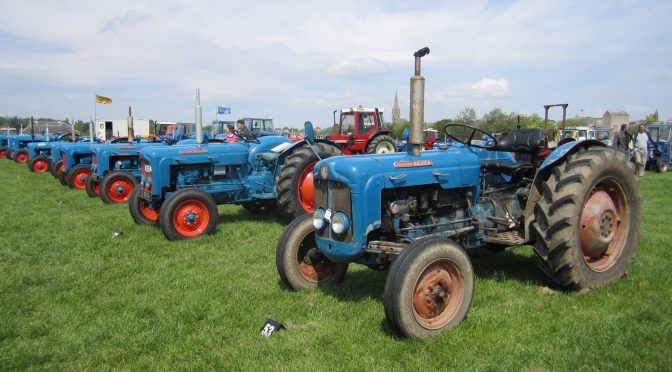The Board of Agriculture and Internal Improvement’s county agricultural surveys provide a great deal of information about the agriculture and political circumstances of the different counties of Scotland. The 1798 survey of Roxburgh provides a detailed account of the implements and machines in Roxburghshire. It notes:
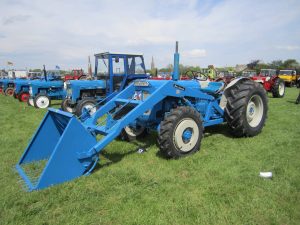
“The Scotch plough, with a long stout beam, and a long narrow point, through still used in stiff clay land, especially when it is to be broken up from grass, and even in light soil, when the furrow is interrupted by stones, has in general given place to the Rotherham plough, improve by Small. The former is thought be some to expose a larger surface to the atmosphere, by which the soil, when harrowed, admits of a finer pulverisation; but the latter is allowed to make a neater furrow, as well as to loosen and turn up more earth from the bottom. it is commonly made exactly according to Mr Small’s model, with this difference, that the beam is two, and sometimes even four inches long. Th moulds (or mould-boards as they are termed) of cast metal, recommended by the dalkeith Society of Farmers, aare much used; and the head or peak, instead of being covered with plates of iron, is not infrequently made wholly of it, or of cast metal. The shath too or sheath, including the head or peak, is sometimes one entire cast piece of cast metal. Opinions differ with respect to the structure of the muzzle. All ploughs have a rod of iron, doubled so as to embrace the beam either perpendicularly or horizontally, with four or five holes in that part of it which crosse the point of the beam, in one or other of which the harness is fixed. This bridge, as it is here called, moves upon a strong pin piercing the beam, about four or five inches from its point in some ploughs, and in others about fifteen or sixteen inches. In the former case, the bridle is placed horizontally, and has a long tail, by means of which, the depth of the furrow can be regulated. In the latter case, piece of wood, with four or five holes in it, is fixed to the end of the beam, sometimes in a horizontal direction, to regulate the width, and sometimes in a perpendicular direction, to regulate the depth of the furrow, by means of the bridle, which is always placed the opposite way from the piece of wood. This structure is preferred, as making the draught more steady. And some use a chain, partly to strengthen the beam, and partly to assist the movement of the plough, in very stiff soil, by the shake which which it occasions.
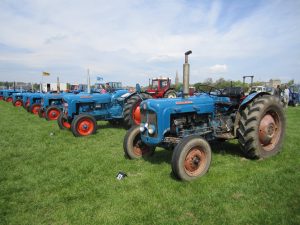
The plough is drawn by a strong stretcher, commonly called a two horse tree, with an iron staple in the middle, and a hook in it to go into one of the holes in the bridle, and with two iron ends, in each of which there is a hole to receive a smaller hook coming fro the middle of two lesser stretchers, or single horse trees, to whose extremities the ropes were formerly tied, and now the chains are fastened, which reach from both sides of the collars of two horses placed abrest.
The common harrows are chiefly used, but are made in a neat and substantial manner. the thick bars are not weakened by large round holes, to admit stout rods, but are pierced by narrow oblong slits, into which thinner bars are nicely and firmly mortised. To prevent one from jutting love another, they are joined together, sometimes by a strong stick, each end of which moves up a pivot, and sometimes by a ring sliding on two iron rods fixed on the approximating bars of each harrow; but the most common contrivance is, two or three pieces of wood, placed erect or obliquely in the extremity of the foremost or left-hand harrow, and also of the middle one when three are drawn together. The improved harrows by Mr Low at Woodend, a plate whereof he has given in his “General View of the Agriculture of Berwickshire”, have made their way into the lower part of this county, and have received still further improvement from Mr Dawson at frogden. He draws them by the ends instead of the middle of the stretcher: he places the two hinges exactly on the same line of draught; and he strengthens the principal bars, by the addition of a few diagonal ones. Two chains, fixed both to the harrows and the stretcher, meet at two and a half feet from the harrows, and are fastened to the two horse tree already described. The harrows are in the form of a rhomb, deviating from the square as far as necessary to make the teeth or tines cut the ground at equal distances from each other. Harrows, when square, or of an improper rhomb, may nevertheless be made to go over a large surface, and to cut it at more equal distances, by lengthening one chain, and shortening the other, till the line of draught is brought to the degree of obliquity required.
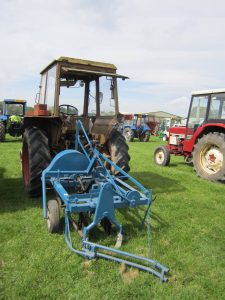
Few or no wagons are now to be found in the county. Nor are two horse carts so numerous as they were some years ago. there can be little doubt that they would be every where superseded by single horse ones, did not the frequent and steep pulls, in the public roads, along with heavy carriages pass, and in several parts of many farms, require two horses. The dimensions of both vary so much in length, breadth,a nd depth, as not to be easily reducible to an average standard. The single horse carts, in general, are about 16 cubic feet, and hold about 16 Winchester bushels or marl or lime in shells, or 10 cwt of coals. The two horse carts are about 25 or 26 cubic feet,a nd for every such fot hold hold a Winchester bushel of mark, or of lime in shells, or 16cwt of coals. Both kinds carry more on particular occasions, but are then heaped, or perhaps are of larger dimensions. The bodies always strengthened by iron stays, tightened by screws. The height of the wheels is from 4 feet 2 inches to 4 feet 6 inches. Iron axles are much used; and they are commonly cased in wood, to render their concussion less hurtful to the horses. there are many timber ones; and they would be still more general, were it not for the danger and inconvenience of their failing in long journies with heavy carriages. Some are of timber, with iron ends having long tails, bolts, and screws. There is a common cart at Riddel, with an additional wheel before to ease the horse’s back. Frames are often put above the common carts for carrying hay, corn or straw, adding about five or five and a half feet to their length, and about three or perhaps three and a half feet to their breadth. But long-bodied carts still continue to be made for these purposes, generally, but not always, with a kind of wings projecting quite over the wheels, supported in the middle by a board set across the top of that cart, and at each end by stout rods resting on cross bars, which, with that view, jut out from the bottom of the body; such a cart is commonly about ten feet long, by seven feet in breadth. It carries a larger load than a frame; and can be more safely conducted through fields that are sidelong and uneven. But it is more bulky and incommodious in the shed, and cannot be laid up or brought forth so quickly, and with so little trouble.
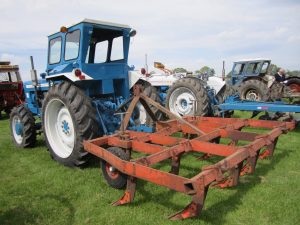
Both Cook’s and Perkin’s patent machines, for sowing different grains in rows, have been tried in this county. They are so constructed, as to make the rows at any distance from 9 to 36 inches. Saw a field of barley, which had been sown with the one, and a field of wheat, which had been sown with the other, in drills nine inches asunder. Both were upon a declining surface, and both looked well. Though apparently thinner than what were sown broadcast on part of the same fields, yet the ears were longer, and the grains in them were larger. There are other machines for sowing turnips, on ridges previously formed by laying together two furrows with a common plough. These are of different forms, mostly drawn by horses, though some are drawn, and others pushed forward by men. All of them have a small coulter to make a slight furrow, or rather rut, on the summit of the ridge, into which the seed drops through a narrow pipe or funnel, immediately behind the coulter. A very light roller precedes the coulter, to smooth the summit of the ridge, and is so long as to go over the one last sown, and cover or gently press down the seed. Some of them have a little barrel, moving on to axis, with holes through which the seed falls, and others have a kind of canister, from which it is shaken, into the funnel or upper end of the pipe. They generally go upon two slender wheels, from two to three feet asunder, according to the distance at which farmers choose to make their ridges. But, where the top of the ridge is tolerably is tolerably smooth, may prefer one wooden wheel, about two and a half or three feet in diameter, and three inches broad in the rim, to go along the very summit before the coulter, and another wheel, less and lighter, to follow it. In this machine the barrel is always used, and turned round, by a pinion, or else by a band connected with the foremost wheel. A very small and light plough, with moulds on each side to shift at pleasure, is drawn by one horse between the rows of potatoes or turnips after they advance a certain length, to suppress weeds, and to stir and lay up fresh earth, from time to time, around the plants.
A portable instrument, for hoeing drilled crops, was made, by the direction of an ingenious young farmer in this county, from a description which he read of it in a publication by an agricultural society at Bath. When it is carried to or from the field, the beam folds back between the handles. When used, one man draws it by the beam, and another directs it by the handles. Instead of a coulter and share, it has only a hoe, which cuts the weeds immediately below the surface; and a larger or smaller hoe can be put in it, according to the width of the drills. In fields free from stones and well dressed, it is very effectual and expeditious.
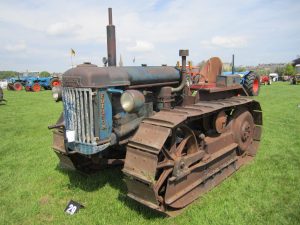
Brake harrows, with huge teeth, some of them very heavy, are used on ground, that is newly broken up, or full of clods, or overrun with inveterate weeds. Rollers, also, both of wood and stone, around every where, and are of very different sizes and weights. It is difficult to manage a strong clay soil without the aid of both these instruments. Mallets, too, are necessary to make a fine mould for barley, especially when clover is sown among it. There is little occasion now for brake harrows on the light soil, as it is, in general, brought into excellent order; but, even on that soil, it is found to be of much advantage to roll barley, wheat, and sometimes oats, immediately after they are sown; and wheat, oats,a nd clover, when in the blade, in spring. The lot designed for potatoes and turnips is likewise frequently rolled.
The common scythes are employed in mowing hay, but corns are cut with the sickle. Both are put upon the cart and stack, with a common two pronged fork. A fork, with three or more stout and long prongs, and a handle three feet long, fills dung into the cart, and spreads it on the field. Lime and mark are spread with a shovel. Both the English and Dutch hoes are used in cleaning potatoes, turnips, and other drilled crops. Stones are loosened, broken, and removed from the earth by picks, large hammers, and levers both of wood and iron. Even gunpowder is sometimes made an implement of husbandry. Docks are taken up with a spade contrived for the purpose. Other weds, especially thistles, are cut with a weed hook. Hedges are pruned and dressed by bills and shears. There are one or two machines for chopping straw, and mashing corn. A spade is preferred to the knife for cutting hay.
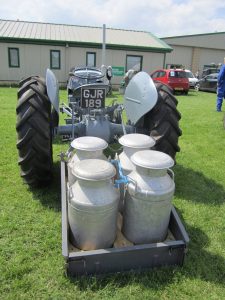
Milk vessels are sometimes scooped out of a piece of solid wood, and nicely turned and smoothed; but more commonly are made of oaken staves; Earthen cans are also used. Churns are of various forms; each mistress or dairy maid preferring that kind, which, she thinks, requires least labour, and is mostly easily cleaned. Cheese presses are constructed on the principles both of the lever and the screw; the last seems to prevail most, especially in pasture farms, where cheese is chiefly made.
In the end of the year 1795, there were only ten thrashing machines in the county. They are now multiplying so fast, that about 20 more were erected during the course of the year 1796, and there will probably be 36 or 40 at work before this account can come from the press. Those first made, either were driven by water, or required four horses, and cost about L80. Though they did great execution, thrashing about 25 and even 30 bolls in a day, yet their weight and clumsiness have induced farmers to try lighter ones, pulled by two horses, which are found to switch from 15 to 20 bolls very completely in 10 hours, and cost only about L40. When fans are attached to either, there is an additional charge of L5 more. Those lately made have all rakes fro removing the straw. It is alleged that, by their circular motion and severe draught, horses are stupefied, become less eager of food, and more unfit for their usual work. It is also alleged that, in rainy seasons when the corn is little spoiled and the straw moist, they perform the work very imperfectly.
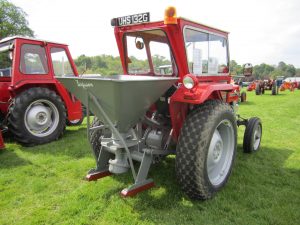
This county can boast, not indeed of inventing fans, but of being the first in Scotland where they were made and used. It is pretty generally agreed, that one Rogers, a farmer on the estate of Cavers near Hawick, about the year 1733, or at least before the 1737, either saw a model or a description of one had been brought from Holland, and that from it, having a mechanical turn, he first made and afterwards improved those, which gradually came to be used in all the neighbouring counties, and which have since received further improvement from his descendants, who fell about 60 of them every year at L3 or 3 guineas each. They are remarkably simple in their construction, and answer the purpose extremely well; but corn mist be put always twice, and often thrice through them, before it is fully cleaned. An improvement upon them has been attempted by one Moodie at Lilliesleaf, which is much extolled by several farmers. He has introduced and happily combined some properties of other fans, by which the moving powers can be more easily regulated, increased, or diminished, and the grain, at one operation, can be both separated from the chaff and lighter seeds, and completely riddled from loose straws, and all other course refuse. The expense d double, the machinery is more complex, and one operation is not always sufficient; but the ingenuity of the structure deserves praise, and may furnish useful hints to such as are employed in attaching fans to thrashing machines.”
Haven’t the implements and machines used in south-east and the Borders changed since then!
The photographs were taken at the Borders Vintage Rally, May 2014.
